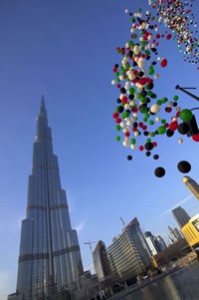Source: www.glassguides.com
The Burj Khalifa, formerly known as the Burj Dubai, was unveiled January 4 and now stands as the world’s tallest building at 2,716.5 feet. Developed by Emaar Properties, glass was a dominant element in the design and construction of the tower.

More than 60 consultants including South Korea’s Samsung Corporation and New York-based Turner Construction International were involved with the design for Burj Khalifa by Chicago-based Skidmore, Owings and Merrill (SOM).
The Burj Khalifa set the record for the tallest installation of an aluminum, silicone and glass façade, and required record-breaking quantities of steel bars and concrete for its construction. With a total of more than 24,000 cladding panels over a total curtainwall area of 132,000 square meters, the tower’s façade was designed to help minimize heat transmission and save energy. The cladding materials were specially made using advanced engineering techniques and include high-performance reflective glazing, silicone sealants and structural adhesives, aluminum mullions and textured steel spandrels with vertical stainless steel tubular fins.
Mohamed Alabbar, chairman of Emaar Properties, says the tower represents a symbol of hope to the Arab world and a shining example of human achievement.
“Thousands of people from more than 100 countries have contributed to the realization of Burj Khalifa. The tower embodies the spirit and optimism of global collaboration, and shows to the world what can be achieved when communities work in partnership.”
The building features more than 2 million square feet of Guardian Solar Silver 20 and Guardian ClimaGuard NLT low-E.
“We’re pleased to have our glass on this prestigious, record-breaking project,” says Guardian Glass Group president Russ Ebeid. “Guardian was able to meet the exacting specifications of the architect and builder.”
In addition, Dow Corning silicones were used to help protect the tower from the harsh desert climate and also to promote its energy efficiency.
“We’ve been involved in many of the landmark buildings around the world for more than 60 years, through curtainwall structural glazing, assembly and weather proofing, insulating glass assembly and interior sealing.
That experience and the proven performance of our silicone technologies played a critical role in this project,” says Ron Fillmore, global executive director for Dow Corning’s Construction Industry.














